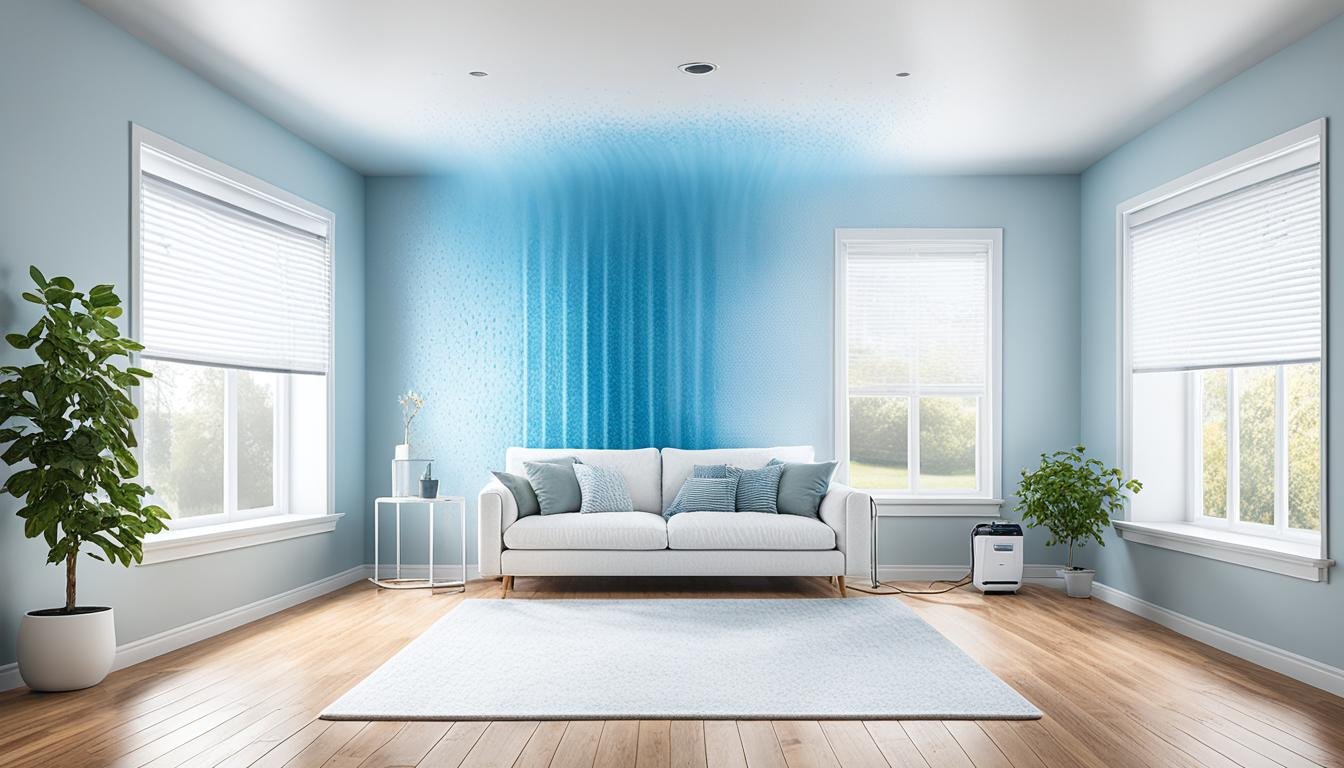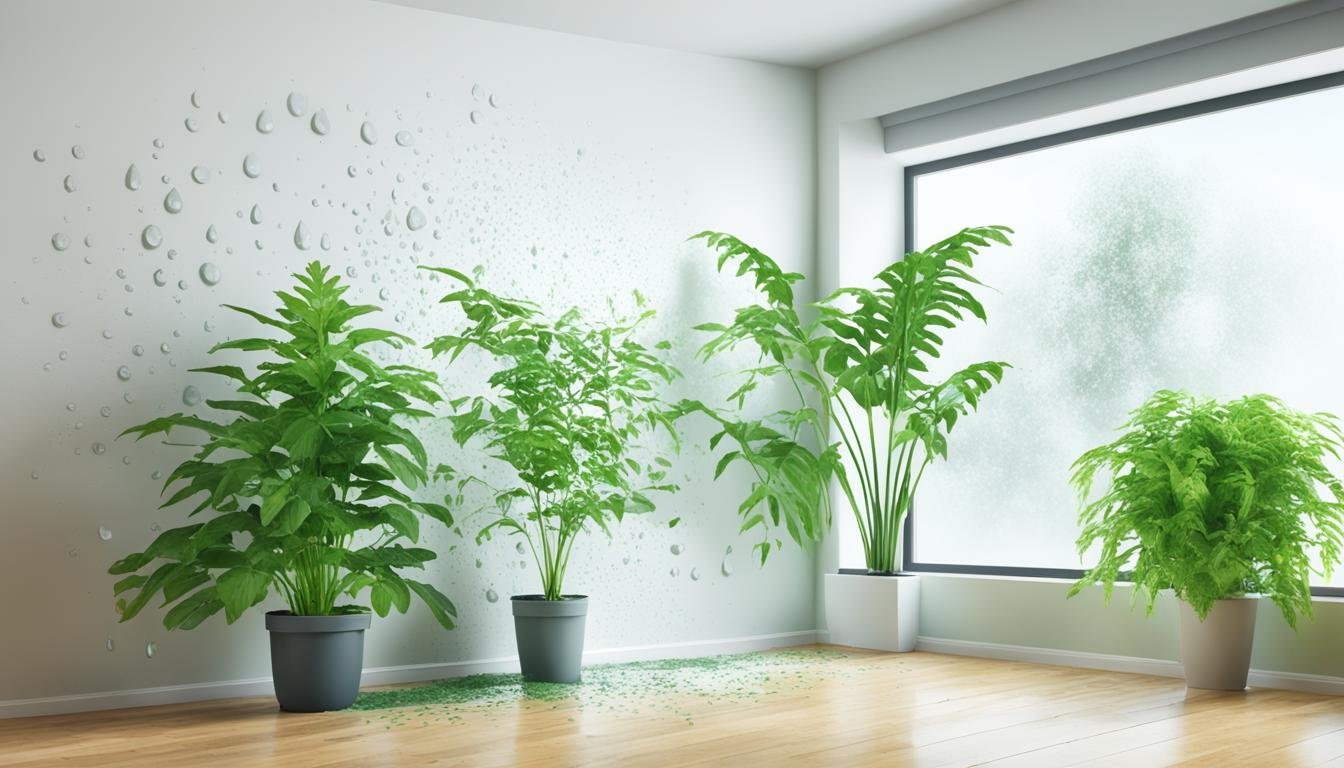Moisture Removal Techniques for Rooms
Did you know that 80% of your home’s moisture can go away with good ventilation? Too much indoor humidity causes discomfort, damage, and health risks. It’s critical to deal with too much moisture to keep your home comfortable and safe. Key Takeaways Proper ventilation can remove up to 80% of indoor moisture Dehumidifiers and air conditioning are effective in reducing humidity Waterproofing basement walls and replacing carpets can combat moisture issues Maintaining gutters and downspouts is essential to prevent water leaks Ideal indoor humidity range is between 45-50% Finding and fixing where moisture comes from is the first step to lower humidity. Signs like wet windows, mold, and bad smells mean you have too much moisture. After pinpointing the issue, use the right techniques to make your home’s air feel better and safer. Identify and Address Sources of Excess Moisture Keeping your indoors comfy and healthy starts with knowing where too much moisture comes from. Signs like condensation, mold, and musty smells need your attention fast. They often point to hidden moisture problems. Condensation on Windows and Surfaces Condensation happens when warm, wet air meets cold surfaces like windows or walls. High indoor humidity is a common cause, which can lead to mold. To fix this, you need to find and solve the real problems. These might be poor airflow, leaks, or lots of moisture in the air from cooking or showering. Mold Growth and Musty Odors Mold loves damp places and can grow on walls and ceilings. It brings a musty smell with it. If you see mold, know there is too much moisture. This can be risky for your health. To stop mold, fix things that make your home too humid. This includes leaks, high moisture, and bad air flow. Solving the moisture issue is key for a safe and cozy home. Take action early to avoid costly damage. Addressing condensation, mold, and bad smells does more than improve your home. It keeps you and your family healthy. “Controlling moisture is the single most important factor in preventing and remediating mold growth in buildings.” – Environmental Protection Agency (EPA) Leaks in the plumbing system or roof Poorly sealed windows and doors Inadequate ventilation in moisture-prone areas like bathrooms and kitchens High indoor humidity levels from activities like showering, cooking, and drying clothes indoors Groundwater seepage or improper drainage around the home’s foundation By fixing these issues, you gear your home towards a healthier environment. This lessens the risk of mold, mildew, and other water-linked problems. Ventilation and Air Circulation Strategies Good air flow is key to a healthy and cozy indoor space. You can keep your home’s air fresh by using the right ventilation methods. This helps in fighting off too much moisture, controlling humidity, and making sure your space is easy to breathe in. Use Fans and Open Windows It’s easy to improve air flow by simply using fans and opening up windows. Fans stir the air, helping to dry up any extra moisture and making the indoors feel nicer. Opening windows, especially in places that get very damp like the kitchen and bathroom, lets in new air and brings down humidity. Install or Upgrade Ventilation Fans Getting high-quality ventilation fans is a good move to make. They boost air circulation and help in managing moisture. Make sure they blow air outside, not back into your living areas. Running them a bit longer after activities like cooking or taking a shower takes out extra humidity very well. Proper Ventilation for Moisture-Prone Areas It’s vital to focus on getting good airflow in places that often get wet. Kitchens and bathrooms are top of the list, as they usually have steam and moisture in the air. Adding or improving ventilation fans here can keep air moving and stop too much water from building up. This also helps prevent problems like mold. Key Benefits of Optimizing Air Circulation Enhanced Comfort Improved Productivity Healthier Environment Energy Efficiency These tips will help you make your living space more comfy, efficient, and healthy. They solve issues related to extra moisture and bad air quality. “Proper ventilation is not only essential for maintaining a comfortable indoor environment, but it also plays a crucial role in protecting the structural integrity of your home and promoting overall health and well-being.” Moisture Removal Techniques for Rooms Keeping indoor spaces comfortable means controlling moisture effectively. Dehumidifiers and air conditioning are key players. They manage the amount of water in the air. Also, adjusting home furnishings and improving ventilation can reduce extra moisture. Dehumidifiers and Air Conditioning Units Dehumidifiers are great for pulling excess water out of the air. They make indoor areas feel drier and nicer without cooling. Meanwhile, air conditioners cool the air while taking out its moisture. This combination helps maintain a dry, cool environment indoors. If you live in a place with a lot of moisture, like near water or in a humid climate, these devices are extremely helpful. It’s important to keep them maintained regularly. This ensures they work well at keeping indoor humidity under control. Cover Indoor Plants’ Soil Indoor plants add to the moisture in the air by releasing water vapor. To lower humidity, cover the soil of potted plants with gravel or moss. This limits how much moisture gets into the air around your plants. It’s a simple way to keep humidity in check. Replace Carpets with Moisture-Resistant Flooring Carpets can hold a lot of moisture and cause issues like dust mites. To avoid this, think about switching to flooring like hardwood, tile, or luxury vinyl. These choices don’t soak up as much moisture. They help keep your home dry and healthy. Using a mix of these methods can make your home more comfortable. It can solve the problems that too much humidity brings. Technique Benefits Dehumidifiers Effectively remove excess moisture from the air without the need for cooling, creating a drier indoor environment. Air Conditioning Units Absorb warm, humid air and replace it with cooler, drier air, providing both …



